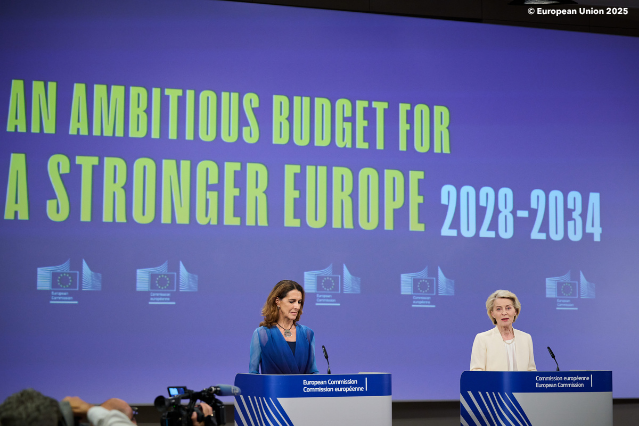
On 16 July, the European Commission presented its Multiannual Financial Framework (MFF), the EU’s seven-year budget for the 2028 to 2034 period. Totalling €2 trillion, or 1.26% of each Member State’s national income on average, the new budget sets out to address the Union’s current and future priorities, from competitiveness, security and defence to energy and climate resilience. In particular, the Commission proposes a fivefold increase in funding for defence, security and space compared to the previous MFF.
The proposal includes a complete overhaul of the current budget’s structure, aiming for simpler, more streamlined allocations and greater flexibility to respond to crises and act swiftly. Central to this ambition is the creation of a new €409 billion European Competitiveness Fund, designed to accelerate public and private investments in strategic technologies. Drawing on recommendations from the Letta and Draghi reports, the fund will focus on four key areas: the clean transition and decarbonisation; the digital transition; health, biotech, agriculture and the bioeconomy; and defence and space.
Closely linked to this new fund, the EU’s Research and Innovation (R&I) Framework Programme (FP10), which will retain the name Horizon Europe beyond 2027, is set to receive €175 billion, up from €95.5 billion in the 2021 to 2027 period. Despite earlier speculation, the programme will remain self-standing and independent, in line with the preferences of the research community. Its proposed budget, however, falls short of the €200 billion advocated by many of its stakeholders.
Under the new proposal, Horizon Europe will be structured around four pillars, though the tentative budgets for each have yet to be disclosed. Pillar 1, “Excellent Science”, will aim to attract world-leading researchers through an expanded European Research Council (ERC) and the Marie Skłodowska-Curie Actions (MSCA), in line with the recent “Choose Europe” initiative. Pillar 2, “Competitiveness and Society”, will focus on collaborative R&I in areas of high societal relevance such as the clean transition, digitalisation, defence, industry and space. This pillar will also house the EU Missions, a simplified Partnerships framework, and the New European Bauhaus Facility. Its exact articulation with the European Competitiveness Fund remains to be clarified.
Pillar 3, “Innovation”, will include a significantly expanded European Innovation Council (EIC), funding high-risk, disruptive projects and following the model of the US Advanced Research Projects Agency (ARPA). A key development is the inclusion of support for defence and dual-use start-ups, marking a shift from Horizon Europe’s traditional focus on civil applications. Finally, the newly established Pillar 4, “European Research Area (ERA)”, will aim to create a unified ERA, including support for Member States with lower R&I capacities and the development of research and technology infrastructures. The new Horizon Europe will also introduce “moonshot projects” spanning research, demonstration and real-world deployment in areas such as quantum computing, clean aviation and fusion energy, although their placement within the different pillars remains unspecified.
Of particular note is the budget’s revenue structure. Beyond Member States’ contributions, significant funding will be drawn from the EU’s green transition mechanisms. The Emissions Trading System (ETS) and the Carbon Border Adjustment Mechanism (CBAM) are expected to generate €9.6 billion and €1.4 billion annually, respectively, underlining the EU’s strategic focus on climate and energy. In line with this, the proposal introduces a horizontal principle whereby 35% of the budget must support climate action and environmental objectives. While this equates to roughly €700 billion, some environmental groups have criticised the absorption of the LIFE Programme into the Competitiveness Fund, warning that nature restoration may be deprioritised. Moreover, they argue that the proposed climate and biodiversity allocations remain below current levels, which stand at €658 billion for climate and €113 billion for biodiversity.
However, all these figures remain provisional. The proposal must now undergo extensive negotiations between the co-legislators, with a final agreement expected by the end of 2027. In the last cycle, similar talks led to a €25 billion reduction in the Framework Programme’s initial allocation, followed by a further €2 billion cut during the mid-term review. This time around, observers expect equally tough negotiations. The European Parliament has already expressed its disappointment with the proposal, criticising the lack of consultation and insufficient ambition, particularly concerning critical priorities, while Germany, the largest net contributor to the EU budget and a member of the so-called “frugal” group of Member States, has expressed its opposition to the proposed increases, all elements which will contribute to creating a complex and challenging policy, political and legal battle ahead.